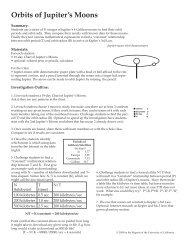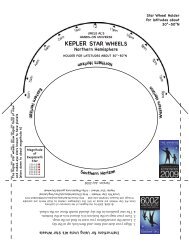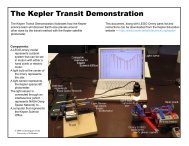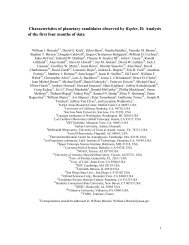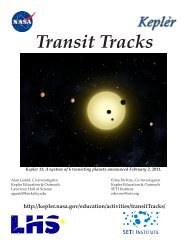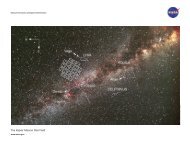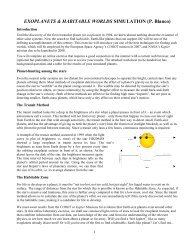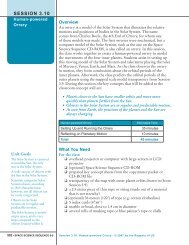Poster Abstracts - Kepler - NASA
Poster Abstracts - Kepler - NASA
Poster Abstracts - Kepler - NASA
- No tags were found...
You also want an ePaper? Increase the reach of your titles
YUMPU automatically turns print PDFs into web optimized ePapers that Google loves.
POSTER ABSTRACTSP1002. POSTER SESSION IIRECENT OPERATIONAL IMPROVEMENTS TO HIGH PRECISION PHOTOMETRICOBSERVATIONS WITH WARM IRAC. S. Carey 1 , J. Krick 1 , J. Ingalls 1 , K. von Braun 2 , J. Stauffer 1 , D. Charbonneau3 , S. Ballard 3 , M. Fisher 4 , R. Olds 4 , 1 Spitzer Science Center, MS 220-6 Caltech, Pasadena, CA 91125;carey@ipac.caltech.edu, 2 IPAC, 3 Harvard-Smithsonian Center for Astrophysics, 4 Lockheed Martin Denver.The Spitzer project has recently made several improvementsto the warm IRAC staring mode observations.This type of observation is critical not only forconfirming <strong>Kepler</strong> planet candidates [1], but also formeasuring transiting exoplanet atmospheric thermalprofiles [2], atmospheric chemical compositions [3],and global wind and energy transport mechanisms. TheIRAC 3.6 and 4.5 µm observations have significantphotometric systematics due to a coupling of telescopemotions with intra-pixel gain variations. These systematicsare being trended with increasingly sophisticatedtechniques [4,5]. To mitigate the effect of thesesystematics in the data themselves, a cycling of a onboardheater was modified to reduce by ~50% both theamplitude and period of the pointing wobble, therebyreducing the aliasing of transits and improving photometricaccuracy.Most recently, we have commissioned a peakupmode to improve pointing for IRAC observations. Figure1 displays the results of an experiment testing therepeatability and stability of the peakup mode. Asshown, almost all of the ten individual observationsland in the same 0.2 x 0.2 pixel region (which hasminimal gain variation, the sweet-spot) with each epochhaving excellent scatter (0.03 arcsec, 1σ radial rmsover 2 minutes). This is a factor of 10 improvementover blind pointing. The peakup uses the opticalpeakup instrument (PCRS [6]) on the cryogenic focalplane previously used with great effectiveness with theIRS spectrometer. Preliminary high-precision (~10 -4 )gain maps of the sweet-spots will be presented. Coupledwith science data taken at these sweet-spots, thegain maps permit observers to remove systematics inthe photometry due to intra-pixel gain without selfcalibratingtheir observations. Not only will this improvethe removal of the systematics and precision ofthe observations, but it also lessens the likelihood ofmodifying scientifically interesting signatures such asatmospheric variations of the exoplanet or host star.The peakup mode has been demonstrated for targetstars with visible magnitude between 7 and 12.5 withfainter targets limited by the amount of data that can bestored and processed by the on-board computer whilebrighter sources saturate the PCRS detector. Forsources outside of the peakup magnitude limits, preliminarytests have shown that the available PCRSguide stars can be used to accurately place the targeton the IRAC arrays. These tests suggest that thepeakup will be available for the full magnitude rangeof <strong>Kepler</strong> exoplanets. We present results of a recentdemonstration using KOI-069.Use of the peakup mode should prove beneficialfor full-phase light curve observations and other staresof greater than 24 hours. By performing peakups every~8 hours, the ~0.3 arcsec/day pointing drift seen inlong stares can be mitigated, while other solutions continueto be explored. In addition, tests are ongoing todemonstrate that light curves can be sampled sparselyand still recover phase variations. Sparse sampling hastwo benefits over traditional full-phase monitoring; 1)the curve can be sampled using ~50% of the observingtime, and 2) the observations can be scheduled moreflexibly, improving the likelihood of having the observationexecuted.Full commissioning of the mode is ongoing withthe expectation that all high-precision photometricobservations will use peakups by the beginning of2012. Use of the mode can continue as long as Spitzeris operating and should permit photon-limited followupand characteriztion of all <strong>Kepler</strong> discoveries.References: [1] Fressin et al. (2011)arXiv:1105.4647. [2] Beerer et al. (2011) ApJ, 727, 23.[3] Fortney et al. (2011) arXiv:1109:1611. [4] Ballardet al. (2010) PASP, 122, 897. [5] Demory et al. (2011)A&A, 533, A114. [6] Mainzer & Young (2004) SPIE,5487, 93.Figure 1: Centroid positions for ten epochs of the4.5 µm subarray PCRS peakup test. Each epoch (representedby a different color) consists of an initial slewto the PCRS, peakup on the PCRS, offset to IRAC and2.25 minutes of 0.4 second frames while staring. Thebox indicates the 0.2 x 0.2 region of the pixel withminimal gain variations that (sweet-spot).2011 <strong>Kepler</strong> Science Conference - <strong>NASA</strong> Ames Research Center 205



